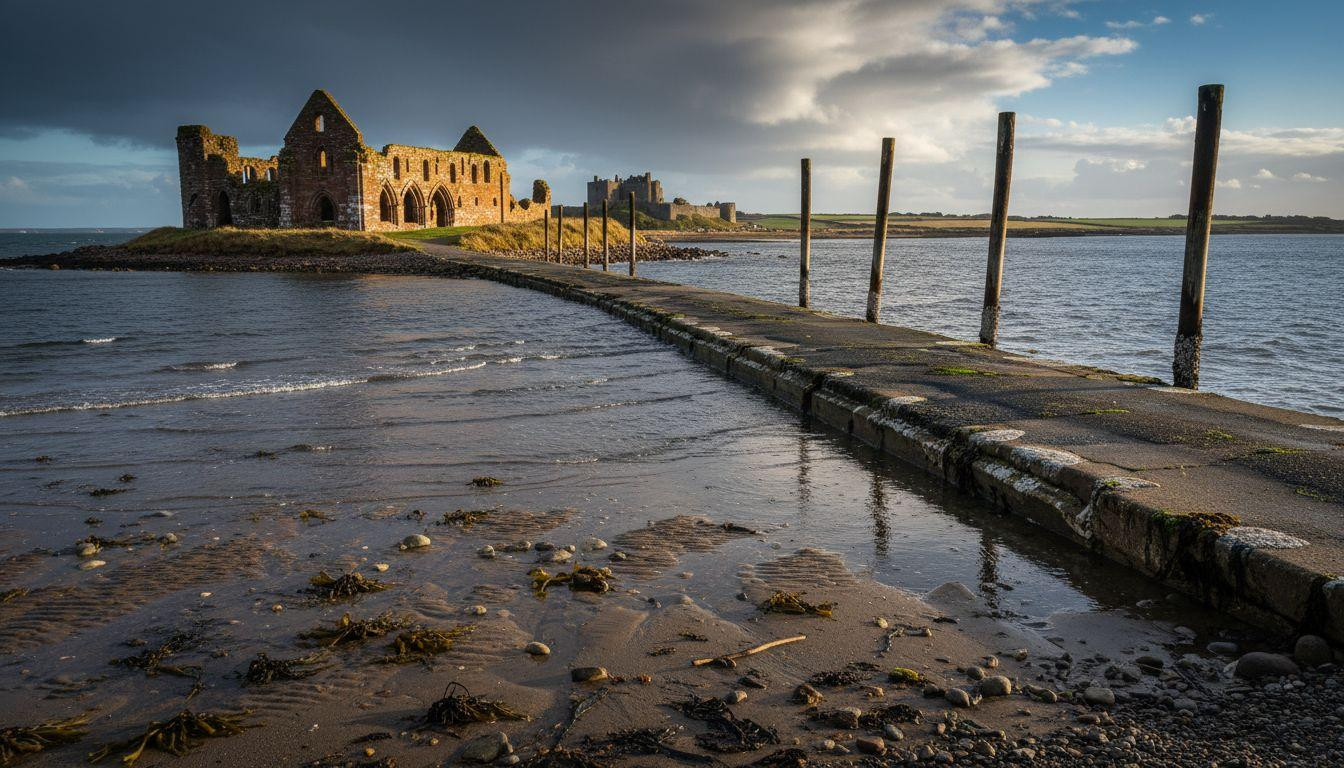Morning light catches golden sandstone across dark water as Holy Island emerges from North Sea mist. The causeway behind you vanishes beneath 6 feet of saltwater, isolating this mile-offshore sanctuary until evening tide. For 1,300 years, twice daily, Lindisfarne has enforced the same temporal rhythm on pilgrims and Vikings alike. While Mont Saint-Michel drowns in 3+ million tourists annually, this Northumbrian refuge preserves medieval silence through nature’s own crowd control.
Where the North Sea commands your schedule
Holy Island sits one mile off England’s northeast coast, accessible only during precise tidal windows. Today’s safe crossing times: 04:25-11:35 AM and 4:45-11:45 PM. The 3-mile causeway submerges under 4-6 feet of seawater twice daily, reaching flow speeds of 9 knots during peak surge.
From London, the journey requires 5-6 hours by train or car, covering approximately 350 miles. Newcastle International Airport lies 70 miles south, while the Scottish border runs just 6 miles north near Berwick-upon-Tweed. The causeway itself spans 3 miles of tidal flats, constructed 9 inches above sand level to withstand winter storms.
Warning signs along the route aren’t tourism theater. Tidal flows trap dozens of vehicles annually. When exiting early during receding tide, locals count refuge poles: if water retreats from the base of the first five markers, the causeway clears. This castle where 1,400 years of history rises 150 feet above the North Sea shares the same dramatic coastline 6 miles south.
The priory where Vikings changed medieval history
Saint Aidan’s 635 AD foundation
Lindisfarne Priory rises from windswept moorland in warm golden-red sandstone, quarried locally and weathered by 1,000 years of North Sea storms. The church displays characteristic Norman Romanesque architecture: pointed arches, carved stone capitals, and thick walls that frame views of endless horizon. Thomas Girtin’s 1801 watercolor specifically captured this “distinctive red colour of the sandstone.”
Saint Aidan established his monastery here in 635 AD, creating Christianity’s northern stronghold. The Lindisfarne Gospels, illuminated around 700 AD, remain among Europe’s greatest medieval manuscripts, now housed in the British Library. This scriptorium trained clerics across Christendom.
The 793 AD Viking raid that echoed across Europe
June 8, 793 AD changed medieval history. Vikings struck Lindisfarne in the first recorded Norse monastery raid. The attack reverberated through Western chronicles, crystallizing Christian perceptions of the Viking threat. The community eventually fled, though pilgrims never stopped coming. Present ruins date from the 12th-13th centuries, rebuilt after Norman conquest.
What the causeway teaches about time
The liberation of enforced rhythms
Visitors report profound temporal disorientation, not as discomfort but liberation. The tidal schedule doesn’t constrain; it releases external demands. You cannot rush Lindisfarne. Natural rhythms override calendars, creating what travel accounts describe as “stepping outside of time.”
The island maintains minimal commercial activity: one seasonal café, no hotels, few shops. Medieval ruins and endless moorland induce slower awareness impossible in conventional tourism. These Irish villages where thatched cottages and medieval ruins rival Galway offer similar monastic heritage away from crowds.
November’s atmospheric gift
Mid-November provides 7-8 hours of usable daylight with frequent wind and occasional rain. Challenging conditions reward contemplative visitors. Summer’s peak crowds (July-August) yield to profound solitude. Low-angle sun illuminates priory stone in deep amber tones while shortened daylight intensifies medieval isolation.
The combination of harsh weather, tidal restrictions, and minimal infrastructure creates conditions where visitors cannot remain passive consumers. Active engagement with environment demands becomes pilgrimage.
The practical reality of tidal pilgrimage
Accommodation exists in surrounding villages: budget guesthouses from $45-65 nightly, mid-range hotels $80-130. The island offers minimal dining beyond its seasonal café. Nearby villages serve authentic Northumbrian specialties: locally caught crab, kipper fillets, pease pudding, and stottie cakes (regional flatbread).
English Heritage manages priory entry at approximately $8-10. Daily budgets average $80-130 per person excluding accommodation, significantly less than major UK heritage destinations. The island’s power derives precisely from resisting tourism convenience. This Atlantic island 45 minutes from France shares similar medieval castle heritage and coastal isolation.
Lindisfarne welcomes approximately 650,000 visitors annually, compared to Mont Saint-Michel’s 3+ million. The difference shows in preserved spiritual atmosphere and accessible pricing.
Your questions about Holy Island of Lindisfarne answered
Is Lindisfarne worth visiting in winter?
Absolutely. November through February offers maximum solitude, dramatic light quality, and authentic contemplative atmosphere. Summer provides longer daylight and milder weather but significantly more crowds. May-June or September represent optimal balance: adequate daylight, manageable visitor numbers, still-dramatic atmospheric conditions. Winter storms create particularly powerful photography opportunities.
How does Lindisfarne compare to Mont Saint-Michel?
Mont Saint-Michel receives 3+ million annual visitors versus Lindisfarne’s 650,000. Lindisfarne maintains active pilgrimage function rather than primarily tourism, offers genuine isolation through tidal restrictions, and costs 40-50% less daily. The spiritual authenticity difference proves profound. This Cotswolds market town with authentic medieval heritage provides another English alternative to overcrowded destinations.
What makes the tidal causeway so important spiritually?
The causeway functions as threshold between worlds. The 20-30 minute crossing allows gradual transition from mainland time to island time, creating visceral understanding of geological forces operating independent of human preference. Medieval pilgrims walked this same route, marked by timber poles, surrendering schedules to tidal rhythms that continue today.
The tide turns at 3:45 PM as winter light dies over Norman arches. Tomorrow’s causeway opens at 4:25 AM for pre-dawn crossing when the island belongs to pilgrims and seabirds alone. Lindisfarne doesn’t accommodate visitors; it transforms them through enforced encounter with forces larger than convenience.
